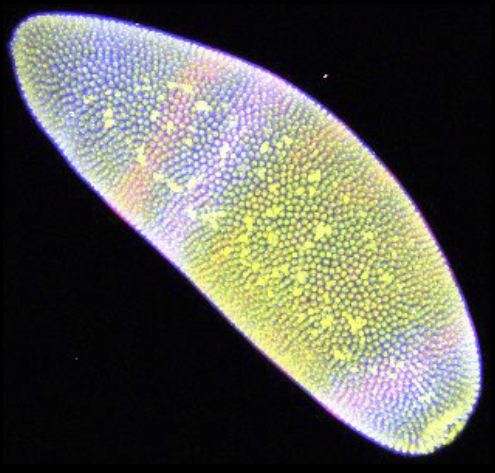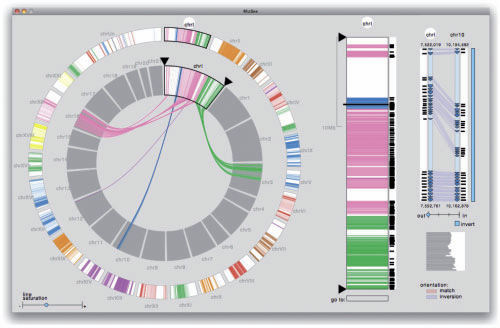Visualization
Visualization, sometimes referred to as visual data analysis, uses the graphical representation of data as a means of gaining understanding and insight into the data. Visualization research at SCI has focused on applications spanning computational fluid dynamics, medical imaging and analysis, biomedical data analysis, healthcare data analysis, weather data analysis, poetry, network and graph analysis, financial data analysis, etc.Research involves novel algorithm and technique development to building tools and systems that assist in the comprehension of massive amounts of (scientific) data. We also research the process of creating successful visualizations.
We strongly believe in the role of interactivity in visual data analysis. Therefore, much of our research is concerned with creating visualizations that are intuitive to interact with and also render at interactive rates.
Visualization at SCI includes the academic subfields of Scientific Visualization, Information Visualization and Visual Analytics.

Mike Kirby
Uncertainty Visualization
Alex Lex
Information VisualizationCenters and Labs:
- Visualization Design Lab (VDL)
- CEDMAV
- POWDER Display Wall
- Modeling, Display, and Understanding Uncertainty in Simulations for Policy Decision Making
- Topological Data Analysis for Large Network Visualization
Funded Research Projects:
Publications in Visualization:
  A User Study of Visualization Effectiveness Using EEG and Cognitive Load E.W. Anderson, K.C. Potter, L.E. Matzen, J.F. Shepherd, G.A. Preston, C.T. Silva. In Computer Graphics Forum, Vol. 30, No. 3, Note: Awarded 2nd Best Paper!, Edited by H. Hauser and H. Pfister and J.J. van Wijk, pp. 791--800. June, 2011. DOI: 10.1111/j.1467-8659.2011.01928.x Effectively evaluating visualization techniques is a difficult task often assessed through feedback from user studies and expert evaluations. This work presents an alternative approach to visualization evaluation in which brain activity is passively recorded using electroencephalography (EEG). These measurements are used to compare different visualization techniques in terms of the burden they place on a viewer's cognitive resources. In this paper, EEG signals and response times are recorded while users interpret different representations of data distributions. This information is processed to provide insight into the cognitive load imposed on the viewer. This paper describes the design of the user study performed, the extraction of cognitive load measures from EEG data, and how those measures are used to quantitatively evaluate the effectiveness of visualizations. |
  Branching and Circular Features in High Dimensional Data SCI Technical Report, Bei Wang, B. Summa, V. Pascucci, M. Vejdemo-Johansson. No. UUSCI-2011-005, SCI Institute, University of Utah, 2011. |
 Topological Methods in Data Analysis and Visualization: Theory, Algorithms, and Applications (Mathematics and Visualization), Valerio Pascucci, Xavier Tricoche, Hans Hagen, Julien Tierny. Springer, 2011. ISBN: 978-3642150135 |
  Non-Pinhole Approximations for Interactive Rendering P. Rosen, V. Popescu, K. Hayward, C. Wyman. In IEEE Computer Graphics and Applications, Vol. 99, 2011. |
  Edge Maps: Representing Flow with Bounded Error H. Bhatia, S. Jadhav, P.-T. Bremer, G. Chen, J.A. Levine, L.G. Nonato, V. Pascucci. In Proceedings of IEEE Pacific Visualization Symposium 2011, Hong Kong, China, Note: Won Best Paper Award!, pp. 75--82. March, 2011. DOI: 10.1109/PACIFICVIS.2011.5742375 |
  Visual Links across Applications M. Waldner, W. Puff, A. Lex, M. Streit, D. Schmalstieg. In Proceedings of the Conference on Graphics Interface (GI '10), Canadian Human-Computer Communications Society, pp. 129--136. 2010. ISBN: 1568817125 The tasks carried out by modern information workers become increasingly complex and time-consuming. They often require to evaluate, interpret, and compare information from different sources presented in multiple application windows. With large, high resolution displays, multiple application windows can be arranged in a way so that a large amount of information is visible simultaneously. However, individual application windows' contents and visual representations are isolated and relations between information items contained in these windows are not explicit. Thus, relating and comparing information across applications has to be executed manually by the user, which is a tedious and error-prone task. |
  Caleydo: Design and Evaluation of a Visual Analysis Framework for Gene Expression Data in its Biological Context A. Lex, M. Streit, E. Kruijff, D. Schmalstieg. In Proceeding of the IEEE Symposium on Pacific Visualization (PacificVis '10), pp. 57--64. 2010. ISBN: 424466856 DOI: 10.1109/PACIFICVIS.2010.5429609 The goal of our work is to support experts in the process of hypotheses generation concerning the roles of genes in diseases. For a deeper understanding of the complex interdependencies between genes, it is important to bring gene expressions (measurements) into context with pathways. Pathways, which are models of biological processes, are available in online databases. In these databases, large networks are decomposed into small sub-graphs for better manageability. This simplification results in a loss of context, as pathways are interconnected and genes can occur in multiple instances scattered over the network. Our main goal is therefore to present all relevant information, i.e., gene expressions, the relations between expression and pathways and between multiple pathways in a simple, yet effective way. To achieve this we employ two different multiple-view approaches. Traditional multiple views are used for large datasets or highly interactive visualizations, while a 2.5D technique is employed to support a seamless navigation of multiple pathways which simultaneously links to the expression of the contained genes. This approach facilitates the understanding of the interconnection of pathways, and enables a non-distracting relation to gene expression data. We evaluated Caleydo with a group of users from the life science community. Users were asked to perform three tasks: pathway exploration, gene expression analysis and information comparison with and without visual links, which had to be conducted in four different conditions. Evaluation results show that the system can improve the process of understanding the complex network of pathways and the individual effects of gene expression regulation considerably. Especially the quality of the available contextual information and the spatial organization was rated good for the presented 2.5D setup. |
  Pathline: A Tool for Comparative Functional Genomics M.D. Meyer, B. Wong, M. Styczynski, T. Munzner, H. Pfister. In Computer Graphics Forum, Vol. 29, No. 3, Wiley-Blackwell, pp. 1043--1052. Aug, 2010. DOI: 10.1111/j.1467-8659.2009.01710.x Biologists pioneering the new field of comparative functional genomics attempt to infer the mechanisms of gene regulation by looking for similarities and differences of gene activity over time across multiple species. They use three kinds of data: functional data such as gene activity measurements, pathway data that represent a series of reactions within a cellular process, and phylogenetic relationship data that describe the relatedness of species. No existing visualization tool can visually encode the biologically interesting relationships between multiple pathways, multiple genes, and multiple species. We tackle the challenge of visualizing all aspects of this comparative functional genomics dataset with a new interactive tool called Pathline. In addition to the overall characterization of the problem and design of Pathline, our contributions include two new visual encoding techniques. One is a new method for linearizing metabolic pathways that provides appropriate topological information and supports the comparison of quantitative data along the pathway. The second is the curvemap view, a depiction of time series data for comparison of gene activity and metabolite levels across multiple species. Pathline was developed in close collaboration with a team of genomic scientists. We validate our approach with case studies of the biologists' use of Pathline and report on how they use the tool to confirm existing findings and to discover new scientific insights. |
  Visual Exploration of High Dimensional Scalar Functions S. Gerber, P.-T. Bremer, V. Pascucci, R.T. Whitaker. In IEEE Transactions on Visualization and Computer Graphics, IEEE Transactions on Visualization and Computer Graphics, Vol. 16, No. 6, IEEE, pp. 1271--1280. Nov, 2010. DOI: 10.1109/TVCG.2010.213 PubMed ID: 20975167 PubMed Central ID: PMC3099238 |
  Analysis of Recurrent Patterns in Toroidal Magnetic Fields A.R. Sanderson, G. Chen, X. Tricoche, D. Pugmire, S. Kruger, J. Breslau. In IEEE Transactions on Visualization and Computer Graphics, Vol. 16, No. 6, IEEE, pp. 1431-1440. Nov, 2010. DOI: 10.1109/tvcg.2010.133 |
  Visualizing Summary Statistics and Uncertainty K. Potter, J.M. Kniss, R. Riesenfeld, C.R. Johnson. In Computer Graphics Forum, Vol. 29, No. 3, Wiley-Blackwell, pp. 823--831. Aug, 2010. |
  Connecting Genes with Diseases H Müller, R Reihs, S Sauer, K Zatloukal, M Streit, A Lex, B Schlegl, D Schmalstieg. In Information Visualisation, 2009 13th International Conference, pp. 323--330. July, 2009. DOI: 10.1109/IV.2009.86 This paper presents a visual data mining approach using the combination of clinical data, pathways and gene-expression data. The visual exploration of medical data using pathways to navigate and filter the data allows a more systematic and efficient investigation of problems in modern life science. A multiplicity of hypothesis can be evaluated in the same period of time, enabling a much better exploitation of the data. We present a system for data preprocessing and automatic classification, a set of visualization views and finally the integration in the Caleydo visualization framework, which enables the "coupling" of genetic and a broad spectrum of clinical data. With the help of the Caleydo framework the medical expert can identify connections between genetic parameters, patient subgroups, and drug responses. |












